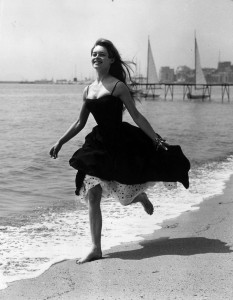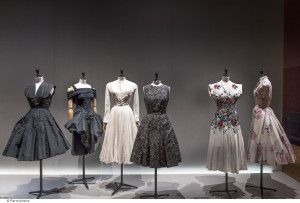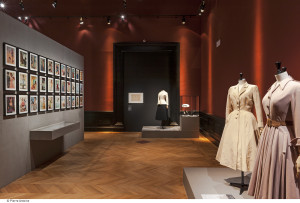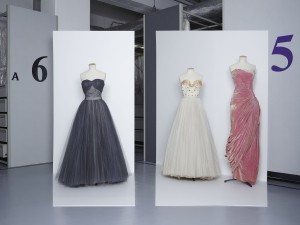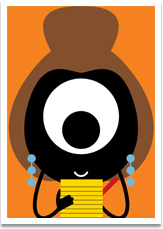From the haughty to the naughty.
Bouncy skirts, tiny waists, floral prints, ballerina slippers – the city streets this summer have such a New Look.
That was the famous phrase used when fashion bounced back with Christian Dior’s designs after the war years.
Oh those fabulous Fifties! I don’t really want to re-live them because this was a period when women were supposed to be charming and mild, throwing off their wide-shouldered wartime working jackets and going back to being polite little wives in controlling corsets.
But the clothes themselves look delicious: hemlines frothing with petticoats and bosoms swelling like the tide, as seen in this photograph of Brigitte Bardot, the flirty young French actress.
A fashion exhibition at the Palais Galliera in Paris focuses on that period. It takes an overview of the decade by displaying covers of <Elle> magazine and <Paris Match>, both of which featured the film star Grace Kelly, who became Monaco’s Princess, in a “daring” two- piece swim suit. The other favourite cover figure was the portly Christian Dior, the king of couture, whose company was the biggest fashion exporter in France.
The 50s exhibition (until November 2), focusing on French fashion from 1947-57, is a triumph for its curator Olivier Saillard. For he has brought together not just the grand life of ball gowns (gorgeous as they are) or the smart day outfits that followed the silhouette of Dior’s famous Bar outfit, but the many other different takes on the period.
As well as the haughty, there is the naughty: the early beach bikinis – all luxuriant Hawaiian patterns and bra-cup tops; and hats, flirty and frivolous with feathers and saucy veils.
Saillard also has an eye for tiny details. He displays the noble sculpted outfits from Cristóbal Balenciaga and the shapely, round-hip dresses of Jacques Fath. But there is also room for an un-labelled transparent plastic handbag, its top decorated with pink roses to match the decorative fresco on the museum’s ceiling.
The revelation for me was summer in the Fifties. I knew about winter, with its smart coats and suits, worn with court shoes and gloves. I was all too aware of the straight skirts that hobbled women at the knees and stopped them from striding forward.
But how much more fun were colourful skirts flaring from the waist and twirling into a patterned hem. The curator even found the more sporty cardigans, pedal-pusher trousers and dresses with pleated skirts and floral or polka-dot patterns. They could walk right out of the museum and on to the street 60 years on.
My favourite was an Hermès dress – so apparently simple, with its “collar” and “pockets” painted with a brush of black on mustard yellow. It could – and should – be in the Hermès windows today.
Of course, there are also the gowns, which take up a large part of the show, whether in all their puff-skirted glamour or reduced to a few lines in the graphic drawings of René Gruau.
Up close, the work on these ball gowns is extraordinary: the three-dimensional flower embroideries on that thick duchesse satin that looks like a sculpture on the body.
Saillard is also eager to show inventiveness, as in a Madame Grès dress, which illustrates her ability to pleat and drape rich materials such as velvet.
Then there are the underthings. The entire decade was focused on nylon stockings, that dream of the wartime years when chic French ladies would draw a fake stocking seam down the back of their legs. On display are the finest Parisian hose with the labels Givenchy or Balenciaga at the point where suspenders clipped stockings at the thigh.
I found the nude-coloured body corset tricked out with lace and bows so pretty that I almost forgot how uncomfortable and controlling it must have been.
It is hard to take a prissy period like the Fifties and make it seem intriguing. Yet Olivier Saillard has used his intelligence and his taste even for carefully chosen film clips of fashion shows in haute-couture houses. (The models look like grandmothers by today’s waif-like standards.)
The Palais Galliera show challenges some fashion clichés. Cristóbal Balenciaga did not make just architectural shapes shadowing the silhouette, but also bouncy dresses with swags of fabric at the hem. And out of the particular Fifties style came another “new look” as Yves Saint Laurent modernised Dior, and then André Courrèges made outfits that created a rupture with the post war period and catapulted style into the swinging Sixties.
But I can prove that the Fifties are still in fashion. When I was in Rome, I saw the joyous work of Andrés Romo, who is making skirts in bright, colourful Mexican materials. They seemed so relevant to the look of this summer.
Then I spotted, at the John Lewis store in London, a dress in the sewing department that could have come straight out of Palais Galliera. With the current revival of home-sewing across the Western world, the look of a fresh cotton dress with a full skirt is ours with a length of cloth, a needle and thread.

